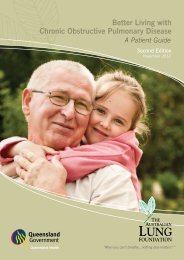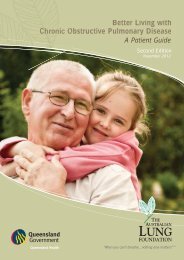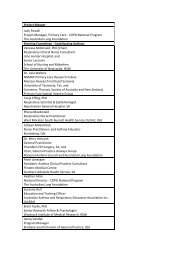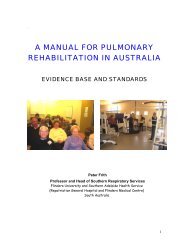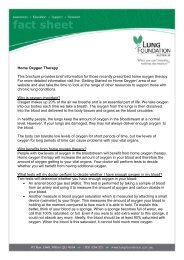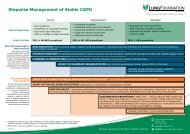Better Living with Chronic Obstructive Pulmonary Disease A Patient GuideSwallowing problems (called dysphagia) can occurbecause the need for oxygen will always overrulethe need to protect the lungs from food or fl uids.What are the consequencesof a <strong>swallowing</strong> problem?Swallowing problems <strong>and</strong> aspirationIf breathing timing is even slightly changed during<strong>swallowing</strong>, the airway may not be fully closed <strong>and</strong>food or fl uid may be breathed into the lungs. Thisis called aspiration <strong>and</strong> may lead to chest infectionsor pneumonia.Normally, when food or fl uid ‘goes down the wrongway’ (aspirated), you automatically cough up thefood or drink. As people who have <strong>COPD</strong> often havea weakened cough refl ex, they may not be able toclear all the food or fl uid out of their breathing tubesor airways.Aspiration is a symptom of <strong>swallowing</strong> problems. Theextent of the <strong>swallowing</strong> problems can change overtime, <strong>and</strong> may depend on how bad your breathingproblems are at the time (<strong>and</strong> other medical factors).As many as 20% to 40% of people who have <strong>COPD</strong>experience aspiration (particularly during a fl are up).Swallowing problems are often under-diagnosed inpeople who have <strong>COPD</strong> because silent aspirationcan be diffi cult to detect.Swallowing problems <strong>and</strong> nutritionAs you are using more energy to maintain yourbreathing during chewing <strong>and</strong> <strong>swallowing</strong>, eating<strong>and</strong> drinking can become more tiring. As a result,you may take longer to complete your meals <strong>and</strong>you may eat <strong>and</strong> drink less. Eating <strong>and</strong> drinkingless could cause you to miss out on importantnutrients <strong>and</strong> lose weight.How can you tell if you areexperiencing <strong>swallowing</strong> problems?Read the following two lists of the common signs of<strong>swallowing</strong> problems. Tick the box next to any signthat you experience when eating <strong>and</strong> drinking:List 1❑ Coughing or choking after <strong>swallowing</strong>food or drinks.❑ Increased shortness of breath during meals.❑ Wet or ‘gurgly’ voice after <strong>swallowing</strong>.❑ Feeling like food is getting stuck in the throat.❑ Diffi culty chewing foods.❑ Taking longer to start a swallow.List 2❑ Food or drink going into your nose.❑ Food or drink remaining in the mouthafter <strong>swallowing</strong>.❑ Refl ux or regurgitation.❑ Taking much longer to fi nish meals.❑ Getting more fatigued after eating <strong>and</strong> drinking.❑ Unexplained weight loss.❑ Unexplained temperatures or changes insputum colour.If you ticked two to three items (particularly those inList 1), or are concerned about your <strong>swallowing</strong>, askyour GP (or respiratory specialist) to refer you to aspeech pathologist who can assess your <strong>swallowing</strong>.69Chapter 16: Chronic obstructive pulmonary disease <strong>and</strong> <strong>swallowing</strong>
Better Living with Chronic Obstructive Pulmonary Disease A Patient GuideHow can speech pathologists helpyou with <strong>swallowing</strong> problems?Speech pathologists are trained to assess, diagnose<strong>and</strong> treat <strong>swallowing</strong> <strong>and</strong> communication problems.They can:Assess your current <strong>swallowing</strong> function <strong>and</strong>determine the cause of your <strong>swallowing</strong>problem.Recommend appropriate foods <strong>and</strong> fl uids, aswell as strategies to improve <strong>swallowing</strong> safety.Start you on <strong>swallowing</strong> therapy, if appropriate.Identify the need for further investigations.Liaise with other health care professionals.If you are experiencing <strong>swallowing</strong> problems,a speech pathologist can give you specific adviceto help you eat <strong>and</strong> drink safely.What strategies can you use to helpmanage <strong>swallowing</strong> problems?Even if you are not experiencing <strong>swallowing</strong> problems,you should be aware that there are a number ofstrategies that can be used to protect the lungs.This knowledge could help you if you do encounter<strong>swallowing</strong> problems (for example, if you have afl are up). These strategies include:Try not to eat or drink when you are breathless.Always sit upright in a supported chair whenyou are eating <strong>and</strong> drinking.Eat slowly <strong>and</strong> take small mouthfuls.Select foods that are soft <strong>and</strong> easy to chew,or add sauce or gravy to moisten foods.If worn at home, oxygen prongs should notbe removed during meals.Have smaller, more frequent meals, <strong>and</strong> takea break during your meal if you become tooshort of breath.Try to breathe out immediately after you swallowto help clear any food or fl uid left in your throat.Alternate between sips of fl uids <strong>and</strong> solids.Try <strong>swallowing</strong> twice per mouthful.Try to minimise talking during mealtimes toreduce the exertion on your breathing.Remain upright for 30 minutes after your meal.If you experience refl ux or heartburn, discussanti-refl ux medication with your GP.Managing <strong>swallowing</strong> problems dueto dry mouthPeople who have <strong>COPD</strong> often experience dry mouth.Dry mouth can be related to oxygen use (via a maskor nasal prongs), mouth breathing or medications.Having a dry mouth is uncomfortable, can increasethe risk of dental problems <strong>and</strong> can cause <strong>swallowing</strong>problems. To reduce dry mouth symptoms:Sip fl uids frequently throughout the day.Always rinse <strong>and</strong> gargle after taking yourmedication or inhalers.Use artifi cial saliva products (for example,Biotene ® or Oralube ® ), available at yourlocal pharmacy, or other oral lubricants(for example, grape seed oil fl avoured withpeppermint essence).Suck sugar free lollies or chew gum.Avoid medicated lozenges or alcohol-basedmouthwashes.Reduce your intake of caffeine, alcohol <strong>and</strong>spicy foods, <strong>and</strong> avoid smoking.Regularly brush your teeth <strong>and</strong> gums(or clean your dentures) to reduce bacteriabuild up in your mouth.Have regular dental check-ups.Talk to your GP about reviewing themedications you are taking.To overcome diffi culties with <strong>swallowing</strong>medications, try cutting or crushing yourmedications <strong>and</strong> mixing them with yoghurt,custard or jam before <strong>swallowing</strong> them.However, as not all medications can be cutor crushed, you should always check withyour GP or pharmacist fi rst.©The State of Queensl<strong>and</strong> (Queensl<strong>and</strong> Health) <strong>and</strong> The Australian <strong>Lung</strong> <strong>Foundation</strong> 201270




